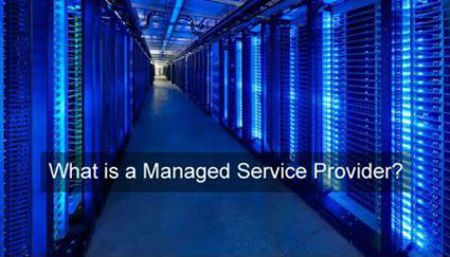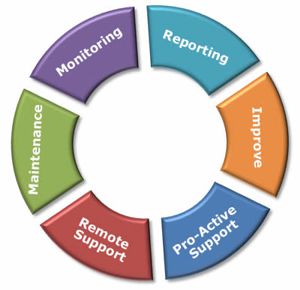 Managed Services allows a business to offload IT operations to a service provider, who is called a Managed Services Provider. The managed service provider assumes an ongoing responsibility for 24-hour monitoring, managing and/or problem resolution for the IT systems within a business.
Managed Services allows a business to offload IT operations to a service provider, who is called a Managed Services Provider. The managed service provider assumes an ongoing responsibility for 24-hour monitoring, managing and/or problem resolution for the IT systems within a business.
Every day more and more businesses are learning the value of and changing to Managed Services for their IT needs.
The following is a summarized history of managed services to give you some background relating to how these services have developed. This history pertains specifically to companies who service midsized to small network systems.
It all started with break-fix services (The Break Fix Mentality)
 Most computer networks for small to medium sized businesses developed as simple systems, usually built by a self-taught network amateur-turned-pro. Maintenance was break-fix only, meaning when something broke, the customer called their technology company and the tech came running to fix it … hopefully. Companies were often times held hostage while they waited for a quasi-computer expert to arrive at their business - often taking days.
Most computer networks for small to medium sized businesses developed as simple systems, usually built by a self-taught network amateur-turned-pro. Maintenance was break-fix only, meaning when something broke, the customer called their technology company and the tech came running to fix it … hopefully. Companies were often times held hostage while they waited for a quasi-computer expert to arrive at their business - often taking days.
As time went on, the best of the support people developed procedures and programs to periodically come onsite to do a system review of logs and user information looking for hints of issues before they became big problems. In some cases an elaborate checklist was used to record disk usage, processor usage, etc.
The problem was support people could only see what was happening on that particular day. Backup problems and other errors continued to occur. If something happened later, they would never know about it … unless the customer called. The only professional test of the backup system was on the visit, which frequently resulted in days or more of missed backups.
The system was prone to other human errors when the onsite technician, trying to be accommodating, would take care of the “end user” symptoms and would not have time to address the “real issues”. This created a constant battle for the tech as they tried to convince customers that they were only causing themselves more dangerous problems down the road by not being proactive.
The next transition of the IT service was companies offering “dialing-in” to fix problems on a business network and not providing any “preventative maintenance” at all. This type of “remote dial-in” service, wasn’t actually monitoring a business’s system, was not able to tell a business where the system was vulnerable and not able to fix problems before they negatively impacted a business’s system’s performance. Remotely “dialing-in” to a network was nothing more than “break-fix” without a site visit.
Companies began to question the break-fix philosophy. A break-fix network maintenance service fixes problems as they crop up. This means that something needs to go wrong before you receive any service, resulting in an inevitable reduction in IT system performance while you wait for the problem to be fixed.
Today, no business can really afford the risk and uncertainty of relying on a “break-fix maintenance service” because your business is too dependent on having a reliable IT system. Furthermore, having separate suppliers responsible for different parts of the system puts you in the difficult position of trying to decide who should be delivering the service you require. You simply do not have time for this.
New alternatives to the “break-fix” scenario began to emerge. The break-fix IT scenario continues to be the way the majority of small to medium sized businesses manage their computer networks. They go about their business every day waiting for something to happen, and when it does, they call in their “computer experts” to save the day … or at the bare minimum, fix the problem.
The truth is there is a much better and cost-effective way to manage your network. Technology solutions for your company have drastically changed over the past 5-10 years - you’ve probably lived through most of them. Can you remember a time when there wasn’t a computer on everyone’s desk? When the only thing available was a tape backup, or when all employees didn’t have access to the internet?
The times change, and technology usually changes with it … not always for the better, but in most cases the solutions that stick around - stick around for a reason. And of course the first companies that benefited from these changes were the ones with money - the Fortune 500 companies…
.....
Managed Services began with Fortune 500 companies and their huge networks
 At the same time the hardware and software vendors were adding new and better ways for the systems to signal problems as early as possible. Simple Network Management Protocol had been developing since the early 90’s and was being applied to PC’s.
At the same time the hardware and software vendors were adding new and better ways for the systems to signal problems as early as possible. Simple Network Management Protocol had been developing since the early 90’s and was being applied to PC’s.
The first systems that could watch these tools and turn all the data into usable information were complex to manage, were geared only to large networks, and were prohibitively expensive for midsized to small business.
In 2005, systems started to mature allowing midsized to smaller companies to take advantage of the same features and benefits as the large companies. This technology started the Managed Services movement.
Finally, Managed Services was available for midsized to smaller sized businesses
 The Managed Services software in place today allows providers to work towards two major goals:
The Managed Services software in place today allows providers to work towards two major goals:
- Everything on your network that will result in a user symptom or risk will send an alert before or when it happens and the Managed Service Provider will know about it.
- Every alert they get is something important and needs to be addressed.
The more closely a Managed Service provider can get to these two goals, the more perfectly they can achieve a truly managed service and the more they can get away from “everything being an emergency” situation.
Exactly what is managed services?
Every day more and more businesses are turning to a Managed Services Company to service their computer and technology needs. But what does managed services actually mean and how can you tell if an IT Support company is not just using the word as a marketing tool, but is in fact only offering “flat rate” services packaged as “managed services’?
As a definition, managed services allow a business to offload IT operations to a company known as a Managed Services Provider. The managed service provider assumes an ongoing responsibility for 24-hour monitoring, managing and/or problem resolutions for the IT systems within a business.
Why the hype with Managed Services?
Just like larger companies, midsized to small businesses need technology to operate efficiently and to compete effectively. As reliance on IT grows the resources needed to support this increasingly complex IT environment may not. In many midsized to small businesses IT resources are limited and can be quickly overwhelmed.
If your business falls behind in keeping up with things such as backups, patches and security, the odds greatly increase that business will face an IT outage or another problem down the road that will negatively impact your business. For instance, if your email server, customer relationship management system, financial application or network goes down, you will likely face substantial productivity and revenue losses as a result.
Managed Services vs. The Break-Fix Mentality
 Managed services are also a philosophical change in the way that a business deals with its technology. Instead of following the old-school tradition of break-fix (literally meaning wait until the server, desktops or other critical networking devices fail, then scramble to fix them) a business operating with a managed service focuses on the prevention of these issues before they disrupt employees, management and/or clients.
Managed services are also a philosophical change in the way that a business deals with its technology. Instead of following the old-school tradition of break-fix (literally meaning wait until the server, desktops or other critical networking devices fail, then scramble to fix them) a business operating with a managed service focuses on the prevention of these issues before they disrupt employees, management and/or clients.
Why Break-fix is no longer good enough for your business
A Break-fix maintenance service fixes problems as they crop up. This means that something needs to go wrong before your business receives any service, resulting in an inevitable reduction in IT system performance while you wait for the problem to be fixed.
Today, no business can really afford the risk and uncertainty of relying on a “Break-fix maintenance service” because your business is too dependent on having a reliable IT system. Furthermore, having separate suppliers responsible for different parts of the system puts your business in the difficult position of trying to decide who should be delivering the service your business requires. You simply do not have time for this.
Do Managed Services Cost More Than Traditional Break-Fix Services?
 Actually no! Surprisingly most managed services cost less than traditional break-fix services. Remote monitoring, remote maintenance and the prevention of major issues allow a managed services provider to be more efficient than a similar break-fix company who is constantly rolling a truck to visit customer sites; therefore the managed service company can offer a “better” service without charging more. Especially when you also factor in the true cost of downtime.
Actually no! Surprisingly most managed services cost less than traditional break-fix services. Remote monitoring, remote maintenance and the prevention of major issues allow a managed services provider to be more efficient than a similar break-fix company who is constantly rolling a truck to visit customer sites; therefore the managed service company can offer a “better” service without charging more. Especially when you also factor in the true cost of downtime.
Why are so many IT Firms now promoting Managed Services?
Because it puts the IT support company on the same page as the business they are serving. With traditional break-fix services, the only way for an IT support company to make money is if something goes wrong - which to an IT support company was always a double-edged sword. If they do their job too well, they’re out of business.
How are Managed Services priced?
Managed services providers usually price their services on a flat-rate monthly basis. Depending on the services included in the program offered, pricing is usually based on the number of devices, with different packages priced at different levels. Some providers offer onsite customer support as an extra fee.
Basic services often start with a monitoring service which notifies the business of problems and the business resolves these issue on its own. At the upper end of the spectrum, service providers offer fully managed services that cover everything from alerts through problem resolution.
The Real Benefits Of Managed Services
 One of the biggest benefits of Managed Services is discovering and fixing problems before they can negatively affect your business.
One of the biggest benefits of Managed Services is discovering and fixing problems before they can negatively affect your business.
A well maintained, proactively serviced computer network will always run better than the alternative. With proactive network monitoring, patch management, and desktop optimization performed on a regular basis, you will notice a tremendous difference in operations … and you will reap the benefits of preventing fires, rather than fighting them.
Reduced costs: Businesses are also able to control and reduce their overall operating costs with the flat-fee billing model. Cost-effective access to enterprise-level support is a reality
24-hour monitoring: Because the Managed Services provider also manages all of your vendor relationships, issues with internet slowness/outages, printers, phones, cell phones, websites are dealt with directly with the vendor by the Managed Service provider. As a result of this “always-eyes-on” network monitoring 24 hours per day, businesses experience an additional level of comfort and security.
6 Additional Benefits Of Managed Services:
- Increased operational efficiency
- Reduced operating costs
- Cost-effective access to enterprise-level support
- Minimized downtime
- Allows the focus to be on running the business, and not the technology
- Worry Free IT Peace of mind from knowing the network is monitored 24/7/365
